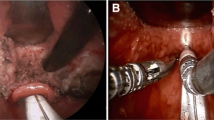Abstract
The purpose of this study was to investigate the relationship between various polysomnographic variables and the success of modified tongue base suspension combined with uvulopharyngopalatoplasty in patients with severe obstructive sleep apnea (OSA). A total of 90 patients who had apnea hypopnea index (AHI) >30 and had both oropharyngeal and hypopharyngeal obstruction were included in this prospective case series with planned data collection. All patients were assessed preoperatively and at the sixth postoperative month by polysomnography. The surgery was considered to be successful when a ≥50 % reduction in the mean AHI to a final AHI of <20/h was obtained. Multiple logistic regression analyses were performed to determine the impact of variables on the surgical success. A total of 67 patients (74.4 %) met the surgical success criteria. The univariate analysis revealed a relationship between success and AHI (P = 0.001), obstructive apnea duration (P = 0.001), sleep time with oxygen saturation below 90 % (ST90) (P = 0.004), minimum O2 saturation (P = 0.0001), mean O2 saturation (P = 0.011), mean O2 desaturation (P = 0.0001), and oxygen desaturation index (P = 0.001). However, ST90 [OR (95 % CI) = 1.40 (1.04–1.89), P = 0.023] was the only independent parameter predicting the surgical success in multivariate analysis. The ROC analysis revealed that the ST90 value of ≤36 min was the best cutoff value with 96.97 % sensitivity (CI 89.5–99.6), 95.83 % specificity (CI 78.9–99.9), 98.5 % PPV (CI 91.6–100.0), and 92.0 % NPV (CI 74.0–99.0). The stratification of patients with severe OSA according to the ST90 may allow better identification of patients in whom surgical success is probable.

Similar content being viewed by others
References
Ho ML, Brass SD (2011) Obstructive sleep apnea. Neurol Int 3:e15
Holmdahl C, Schöllin IL, Alton M, Nilsson K (2009) CPAP treatment in obstructive sleep apnoea: a randomised, controlled trial of follow–up with a focus on patient satisfaction. Sleep Med 10:869–874
Weaver TE, Grunstein RR (2008) Adherence to continuous positive airway pressure therapy: the challenge to effective treatment. Proc Am Thorac Soc 5:173–178
Kotecha BT, Hall AC (2014) Role of surgery in adult obstructive sleep apnoea. Sleep Med Rev. doi:10.1016/j.smrv.2014.02.003
Iber C, Ancoli-Israel S, Chesson A, Quan S (2007) The AASM manual for the scoring of sleep and associated events: rules, terminology and technical specifications. American Academy of Sleep Medicine, Westchester
Turhan M, Bostanci A, Akdag M (2014) The impact of modified tongue base suspension on CPAP levels in patients with severe OSA. Eur Arch Otorhinolaryngol. doi:10.1007/s00405-014-3034-2
DeRowe A, Gunther E, Fibbi A, Lehtimaki K, Vahatalo K, Maurer J, Ophir D (2000) Tongue-base suspension with soft tissue-to-bone anchor for obstructive sleep apnea: preliminary clinical results of a new minimally invasive technique. Otolaryngol Head Neck Surg 122:100–103
Shin SH, Ye MK, Kim CG (2009) Modified uvulopalatopharyngoplasty for the treatment of obstructive sleep apnea-hypopnea syndrome: resection of the musculus uvulae. Otolaryngol Head Neck Surg 140:924–929
Sher AE, Schechtman KB, Piccirillo JF (1996) The efficacy of surgical modifications of the upper airway in adults with obstructive sleep apnea syndrome. Sleep 19:156–177
Friedman M, Ibrahim H, Joseph NJ (2004) Staging of obstructive sleep apnea/hypopnea syndrome: a guide to appropriate treatment. Laryngoscope 114:454–459
Launois SH, Feroah TR, Campbell WN, Issa FG, Morrison D, Whitelaw WA, Isono S, Remmers JE (1993) Site of pharyngeal narrowing predicts outcome of surgery for obstructive sleep apnea. Am Rev Respir Dis 147:182–189
Senior BA, Rosenthal L, Lumley A, Gerhardstein R, Day R (2000) Efficacy of uvulopalatopharyngoplasty in unselected patients with mild obstructive sleep apnea. Otolaryngol Head Neck Surg 123:179–182
Zhang J, Li Y, Cao X, Xian J, Tan J, Dong J, Ye J (2013) The combination of anatomy and physiology in predicting the outcomes of velopharyngeal surgery. Laryngoscope. doi:10.1002/lary.24510
Lin HC, Friedman M, Chang HW, Gurpinar B (2008) The efficacy of multilevel surgery of the upper airway in adults with obstructive sleep apnea/hypopnea syndrome. Laryngoscope 118:902–908
Thomas AJ, Chavoya M, Terris DJ (2003) Preliminary findings from a prospective, randomized trial of two tongue-base surgeries for sleep-disordered breathing. Otolaryngol Head Neck Surg 129:539–546
Vicente E, Marín JM, Carrizo S, Naya MJ (2006) Tongue-base suspension in conjunction with uvulopalatopharyngoplasty for treatment of severe obstructive sleep apnea: long-term follow-up results. Laryngoscope 116:1223–1227
Kim JW, Yoon IY, Chung S, Lee CH, Moon SJ, Yun PY (2009) Comparison between tongue base and soft palate obstruction in obstructive sleep apnea. Acta Otolaryngol 129:855–861
Pang KP, Terris DJ, Podolsky R (2006) Severity of obstructive sleep apnea: correlation with clinical examination and patient perception. Otolaryngol Head Neck Surg 135:555–560
Guilleminault C, Ramar K (2009) Neurologic aspects of sleep apnea: is obstructive sleep apnea a neurologic disorder? Semin Neurol 29:368–371
Kimoff RJ, Sforza E, Champagne V, Ofiara L, Gendron D (2001) Upper airway sensation in snoring and obstructive sleep apnea. Am J Respir Crit Care Med 164:250–255
Ryan CM, Bradley TD (2005) Pathogenesis of obstructive sleep apnea. J Appl Physiol 99:2440–2450
Conflict of interest
The authors declare that they have no conflict of interest.
Author information
Authors and Affiliations
Corresponding author
Rights and permissions
About this article
Cite this article
Turhan, M., Bostanci, A. & Bozkurt, S. Predicting the outcome of modified tongue base suspension combined with uvulopalatopharyngoplasty. Eur Arch Otorhinolaryngol 272, 3411–3416 (2015). https://doi.org/10.1007/s00405-014-3311-0
Received:
Accepted:
Published:
Issue Date:
DOI: https://doi.org/10.1007/s00405-014-3311-0




